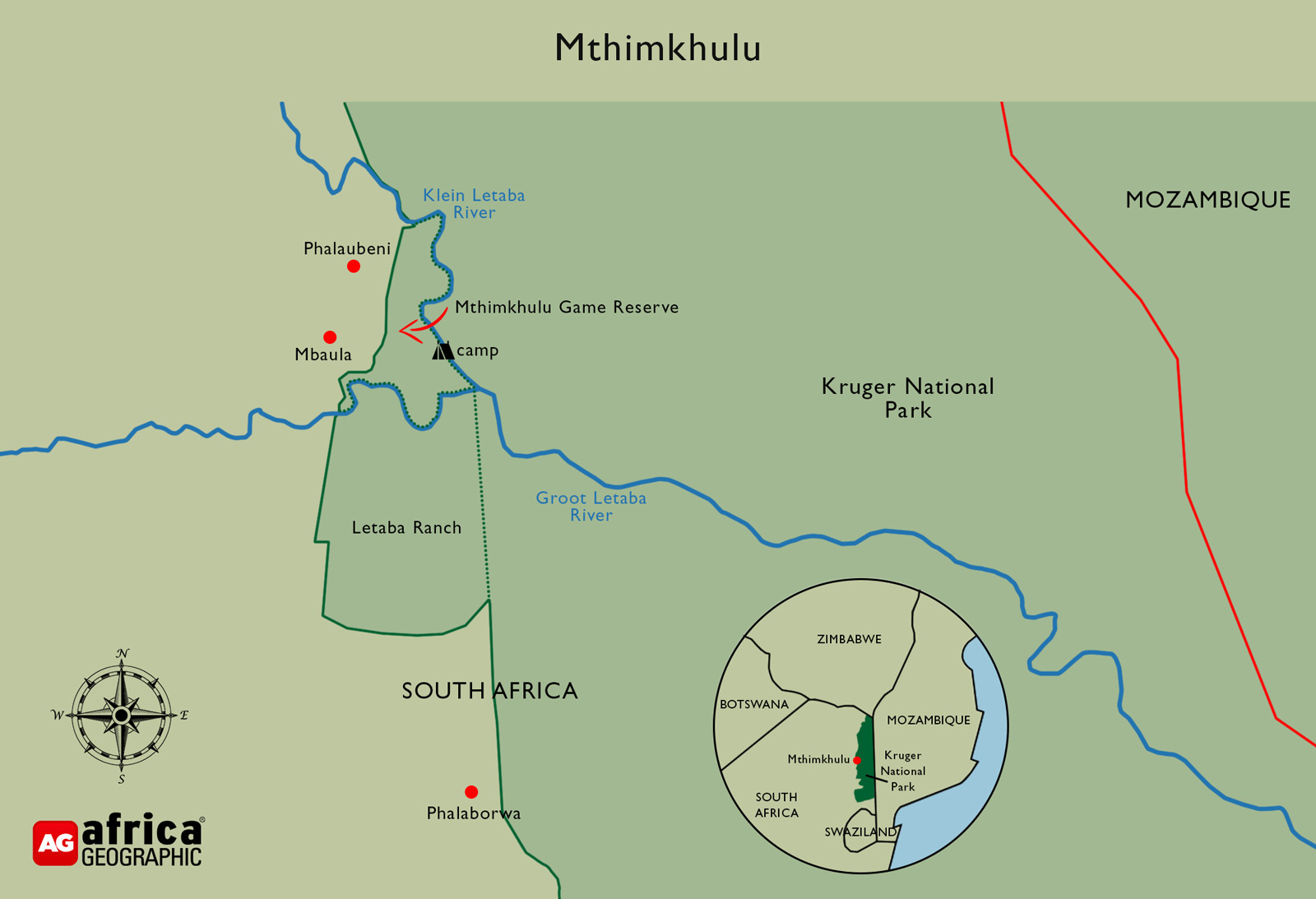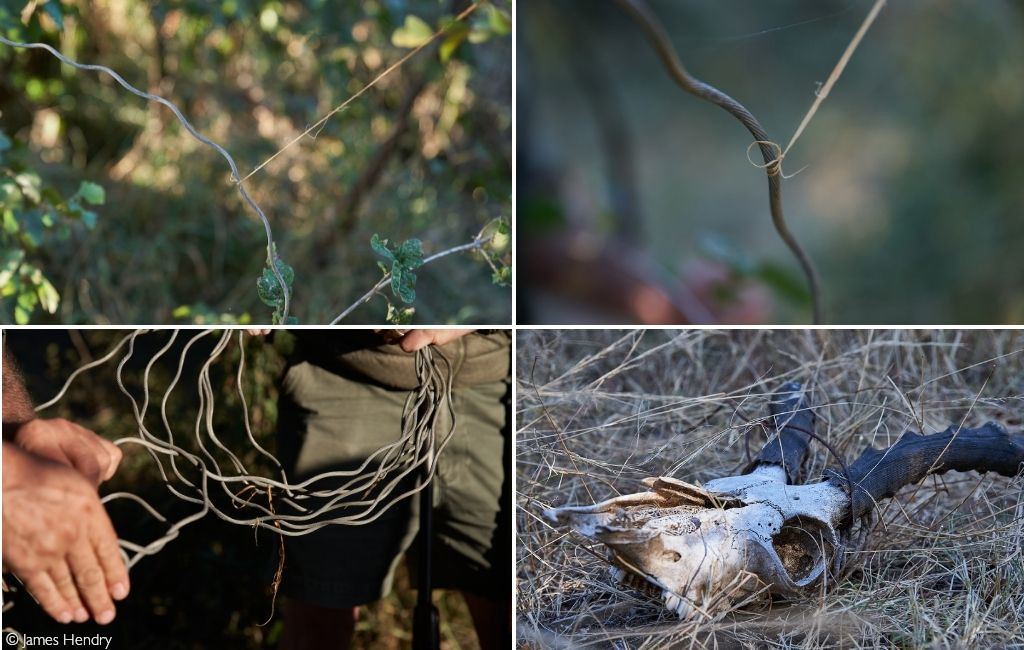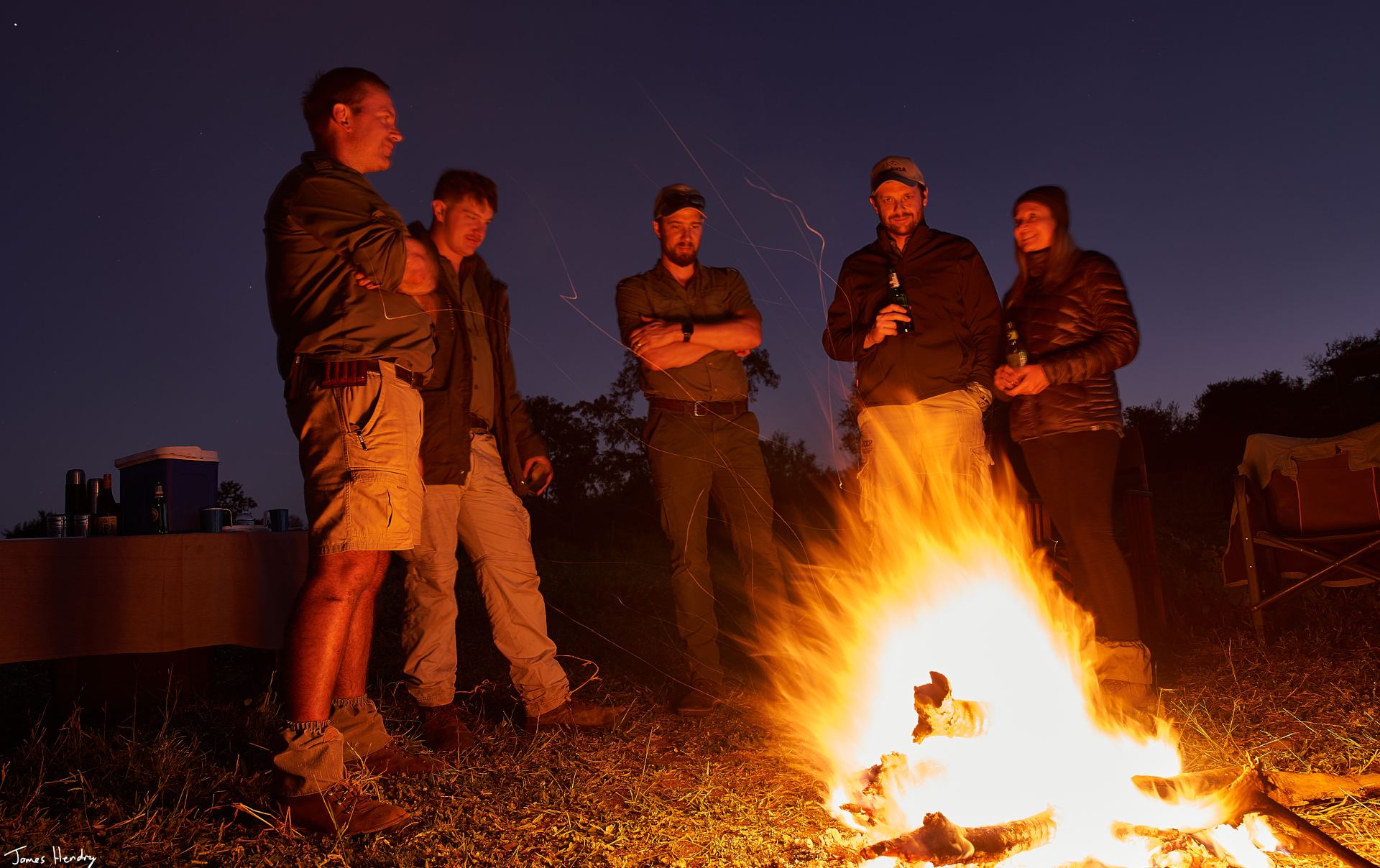
A sorry tale with a hopeful ending

It was cold when I poked my bald head from beneath the covers. It was also dark, but the reduced choir of the winter dawn was giving the overture – time to stagger from my dreams. A few minutes later, a steaming mug in my hands, I walked out to the deck overlooking the Klein Letaba River. A line of gold marked out the eastern horizon, haloing a baobab filled with red-billed buffalo weaver’s nests. As the earth tilted towards our star, I contemplated the Mthimkhulu Game Reserve.

Prime, wildlife real estate
The 8,000 ha Mthimkhulu Game Reserve is part of the Greater Kruger, an open ecosystem with Kruger National Park and the Great Limpopo Transfrontier Park where animals roam more than 3.5 million ha with no internal fences. One would think that an 8,000 ha piece of the Greater Kruger with more than 40 km of river frontage would be a cash cow for the lucky owners. After all, similar land in the Sabi Sands Game Reserve has been valued at more than ZAR 70,000/ha. Let’s be conservative here and halve that for Mthimkhulu because it’s not an established tourist hotspot and the soils and vegetation probably won’t support quite the same density of animals that places in the Sabi Sands might.
So, at ZAR 35,000/ha, we’re looking at a piece of land worth roughly ZAR 245 million. Let’s halve it again just to be safe because there is minimal infrastructure on the reserve, the fences need to be fixed, and a crack anti-poaching unit is required. That gives the owners an asset worth somewhere in the region of ZAR 120 million – still a lot of ZAR.
Yet, on the borders of the Mthimkhulu Game Reserve, about 50 km north of Phalaborwa, there are two of the most impoverished rural villages you could ever hope to find. The people of Mbaula and Phalaubeni should, by rights, be the owners and beneficiaries of this piece of paradise on the Kruger’s western boundary – they are the only people living anywhere near the reserve and were forcibly removed to their current location in 1967.
That they are not benefitting from Mthimkhulu is a long, sad story of callous politics, corrupt trophy hunting and ineptitude of the highest order. Mercifully, things may be turning around for the reserve and, therefore, the people.

On our first morning walk, we left camp heading south, parallel with the Klein Letaba. On the bank, we walked beneath ancient jackalberries, apple leaves (the season’s fallen foliage crunching underfoot), and some of the hugest leadwoods I’ve seen. In the sandy riverbed, our guides from Manukuza Walking Safaris pointed out myriad tracks – buffalo, giraffe, elephant, waterbuck, genet, civet and a male leopard. We also found a dragonfly nymph in a little crystalline pool. As the morning warmed, we shed layers and made for a granite outcrop that, apart from a grazed knee, offered an endless panoramic view of a landscape bathed in the reds, bronzes and greens of the early winter; a landscape that has inspired adventures and dreams for centuries.

Geography
Mthimkhulu is bounded by the annual Klein Letaba River on the east and the perennial Groot Letaba River to the south. The vegetation is a mix of mopane woodland, broad-leafed combretum woodland, marula-topped crests and riverine woodland dominated by apple leaf and jackalberry trees. Several granite koppies stand guard, topped with white kirkias and Natal rock figs, giving stunning vantage of the area. The region receives an annual rainfall of around 550 mm.
The grass sward shows many signs indicating a dearth of large grazing herbivores, the result being swathes of relatively low-grazing value species. This situation can only be remedied by the influx of buffalo, elephant and other bulk grazers – all animals that avoid the reserve because of poaching.
To the south of the Groot Letaba River is the Letaba Ranch, a reserve administered by The Limpopo Department of Economic Development Environment and Tourism (LEDET). As far as the Letaba Ranch is concerned, the only thing accurate in the LEDET name is the word Limpopo. Economic development, environmental care and tourism are phantoms. In practice, the reserve has been plundered, allegedly with tacit approval from officials, hunters, and, if you can believe it, a miner. This fine, upstanding fellow removed half a hillside before a community involved in a land claim chased him off. Parts of the western fence (effectively the western fence line of the Kruger National Park) wouldn’t hinder an asthmatic duiker, let alone an elephant.

We returned to camp around 13h00 and, after some midday snifters and a meal, my seven comrades and I fell into various states of slumber as the perfectly still afternoon passed lazily overhead. The evening stroll netted us a fleeting view of a buffalo bull, who took exception to our exploring and disappeared into the mopane woodland. Perhaps he’d been spooked by the male lion whose pug marks dotted the river bed. There was also an incongruous pool set behind a natural granite weir. Myriad fish shot between the smooth pebbles coloured emerald with algae. The highlight for me was a female painted snipe foraging in a muddy puddle. As dusk fell, we lit a fire on the banks of the river, cooked a basic but delicious meal and shared stories beneath a star-sprayed sky.

Apartheid’s relics
So why is the community living on the reserve’s boundary not benefitting from it? Well, mainly because the government (provincial and national) cannot or will not decide who the correct traditional authority of the area is supposed to be. (The fact that there is a debate over who has the genetic right to benefit from a piece of land in a constitutional democracy is a brain-melting discussion for another time.)
In brief, the chief who claims ownership of the reserve and dominion over Mbaula and Phalaubeni villages, Ngove, lives some 50 km away near Giyani. The chieftaincy was created by the Native Commissioner in the 60s, before the Mthimkhulu community’s forced removal from the Tzaneen area. The Mabunda family, who live in Mbaula, claim that the chieftaincy is theirs. Extensive research completed by a University of South Africa academic indicates that the Mabunda claim is valid. Obviously, Ngove doesn’t want to give up the cash cow that Mthimkhulu could be.
The dispute has been to court any number of times over the last 26 (!) years. For reasons that go well beyond the scope of this story (but including allegations of political collusion and skulduggery), the dispute has never been settled. As I write this, another application based on a constitutional provision that allows communities to benefit from the land they live on, regardless of which traditional authority is in charge, is with the courts. In it, the people of Mbaula and Phalaubeni are applying to benefit from their land without the need for the chieftaincy to be resolved.
The upshot of this convoluted legal/ cultural/ social/ story is that there is no clear landowner. This means that no investor or tourism operator can sign or secure a long-term lease. Without a secure, legally binding lease, money is impossible to raise, and potential investors are understandably reticent.

As the second frigid morning dawned, our guides hustled us into the vehicle before it was light. There was a lot of grumbling. We drove down to the confluence of the Groot and Klein Letaba Rivers, where, finally, we were allowed to mainline some caffeinated liquid as the sun rose over the historic confluence. There is a profound sense of memory about the place. As the mist rose off the water, we could almost sense the ghosts of the Khoisan, refugees from the Zulu wars, ancient traders coming to barter their wares from the coast, and the Boer hunters looking for winter biltong.
Where are the animals?
While all this political tomfoolery has ground on with the speed of frozen treacle mooching uphill, the people of the two villages have suffered through neglect, corruption and unscrupulous trophy hunting operations. For many years, various trophy hunting outfits have plundered Mthimkhulu. They have bribed community leaders for access and made minimal contributions to the running and upkeep of the land from which they took the animals. An estimated 20 million rand has flowed to the hunters over the years, with less than a tenth making it into the villages.
Sadly, poaching is rife. It is essentially meat poaching – some for the pot and some for the commercial bushmeat trade. There is simply not enough financial input to maintain the fences and keep a permanent anti-poaching unit.
Several photo-tourism operators have done their best to obtain a lease for Mthimkhulu because it has such potential. Most have eventually left with their tails tucked firmly between their legs. Without an indisputably legal, long-term lease, no funder with a quarter of a brain is going to invest the kind of money required to develop an ecotourism hotspot. Likewise, no conservation NPO is going to step in and foot the bill for looking after the reserve if there is no certainty. SANParks, who look after the Kruger, will also not get involved until the dispute is settled.
The upshot is a poached and pillaged, yet potentially thriving safari hotspot.

After our warming drinks, we headed inland away from the rivers. Mammals we did not see, but we saw plenty of encouraging signs as we wove between the mopane trees towards another gorgeous koppie. Aardvarks, hyenas, warthogs and buffalo clearly wandered the game paths with relative frequency. On the koppie, we watched a bateleur searching the seemingly endless wilderness for signs of brunch. A zephyr blew the last of the leaves from the Kirkia trees as we contemplated the winter woodlands below. Those ghosts from the confluence seemed to have followed us up, and I couldn’t help but wonder who else had rested on the rocks over the millennia – what marvels they must have seen.
The Villages
Travelling through Mbaula and Phalaubeni, one can scarcely be surprised that some people have taken to poaching – there is very little to eat, and employment is a dream so far from reality it may as well include unicorns. There is no running water and very little in the way of electricity (and only for those who can afford it). The nearest medical facility (and that is to give it a compliment it almost certainly doesn’t deserve) is 20 km away in the village of Makhuba. If you do not have a car and you have a medical emergency, then good luck.
I am always struck by how different the villages feel depending on the time of day. Midday is the worst – the harsh light makes the dusty, litter-strewn lanes, wilting gardens of maize and half-built homes look that much more desperate. But as the evening comes, the light softens, and people – tremendously resilient people – come out of their homes to chat to neighbours. Children play amongst the goats, donkeys and clucking chickens. The sound of cattle bells grows as men return the cattle to their kraals for the night while women light fires for cooking or warmth in their yards. Those with enough cash might head to the local tavern to drink quarts of beer.
Life in these villages is hard. All of the social ills that come with an economically depressed area manifest, yet the people somehow carry on. They collect water from intermittently dry boreholes (often privately installed), clear mopane woodland by hand to plant maize and a few other crops, herd their livestock into the woodlands to graze and do whatever odd jobs they can. The children go to school (covid allowing) and try their best to glean something from the human rights tragedy that is our government’s idea of education.

The afternoon passed like only a Lowveld afternoon can – warm, gentle and smiling. As the sun moved towards the mountains in the west, we made our way onto a massive island of rocks in the middle of the Klein Letaba River. We watched a pied kingfisher trophy hunting one of the pools, silhouetted against the tangerine orb in the west. We listened as the corn crickets crackled at each other. Someone claimed they heard a leopard sawing nearby. Just before dark, we wandered back to our campfire for a sing-song and more stories – stories all the more richly told for the atmosphere created by the fire, the Milky Way and the wilderness where we sat.

Potential
Mthimkhulu’s potential is enormous. Mbaula and Phalaubeni are relatively small villages. There is a lot of communal land outside the reserve that could be incorporated into the fence or be more productively used for farming, grazing or projects that could supply tourism operations. This is not a luxury of which many reserves on the borders of Greater Kruger can boast. A brief gander at a map of the Sabi Sands will reveal villages right up against the western boundary fence – this is not the case for Mthimkhulu.
Two sides of the reserve are bounded by rivers. Mthimkhulu has more river frontage than any other similar-sized private game reserve in the Lowveld. The nearest commercial airport is a 60 minutes drive away (Phalaborwa) on an excellent tar road. It is a shorter, more pleasant drive than, for example, that from Hoedspruit into the northern Sabi Sands, which will leave you in need of severe chiropractic and dental attention. An airstrip could easily be built outside the reserve to service charter flights.
What is needed is a valid authority to sign a valid lease with a seriously innovative tourism operation (or more than one). Ideally, the costs and practicalities of maintaining the reserve should be borne by a conservation NPO in partnership with the government. The land management needs to be cutting edge. Strong consideration should be given to using the herding four health (H4H) model being employed in parts of the Great Limpopo Transfrontier Park, where communities graze their cattle as one herd inside the park according to holistic resource management principles. This will benefit not only the cattle and their owners but also the grasses and soils of Mthimkhulu.

On our last morning, we headed north up the river as the sun poked its head over the Kruger. We were rewarded with an excellent view of a small buffalo herd moving east across the riverbed post a dawn drink (substantially more algae rich than mine had been). We crossed back onto the Mthimkhulu side, cautiously walking along a game path fringed by thick riverine bush when our guide motioned for us to freeze. He went ahead slightly then turned, waving for us to retreat quickly.
‘Go, behind that bush,’ I said to the two behind me. I expected a buffalo to come thundering out of the undergrowth at any second.
‘But there’s a person!’ hissed the sharp-eyed woman in front of me.
‘It’s cattle, not buffalo,’ the guide realised.
Two of us leapt up the bank to see if we could find the man but he’d melted into the mopane. As we returned to join the rest, the guide spotted something shiny in a tree – a thick wire snare, expertly strung with bark sinews, purposed to catch a buffalo.
We spent the next hour removing a total of 24 snares from the area – all made from cable most likely stolen from the Kruger fence just to the north.

A new dawn
There is hope for Mthimkhulu. In the next few months, another court date could well see the disputes finally put to bed. This will allow the people of Mbaula and Phalaubeni to sign a lease with a serious investor. And there are quite a few groups standing by to get things going. One of these is Manukuza Walking Safaris, which is forging ahead and delivering excellent bush experiences on this historical game reserve despite the challenges. If you’re thinking of a rustic, authentic experience in some of the wildest parts of the Greater Kruger that will make a meaningful conservation difference, then give them a shout.![]()

Resources
For more on the politcal, cultural and hunting debacle of the wider area see here
To comment on this story: Login (or sign up) to our app here - it's a troll-free safe place 🙂.![]()




